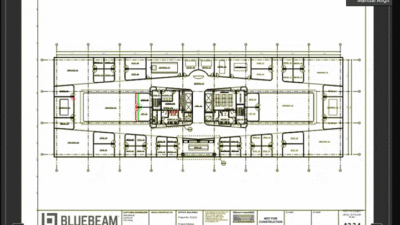Quite often if you are a civil engineer.
It was a question posed by a TikTok user in Sweden. It spawned one of the biggest viral memes of the last month. The hashtag #romanemire had over 1.3 billion views according to a September 2023 CBS News report. Users were prompted to ask the men in their lives how often they think about the ancient Romans. According to the report, most men think about the Romans once a day and one said as often as three times per day.
It seems I have grossly underestimated the number of history buffs walking among us.
For me, a civil engineer with a professional interest in bridges, highways and other heavy infrastructure, the answer to the question that launched a thousand TikTok videos is a few times a month. So, I expect how many times a month most men really think about the ancient Romans is close to zero.
The Romans were a fascinating, brutal society—just as capable of building highways, bridges and aqueducts and inventing indoor plumbing as they were sending gladiators into the Coliseum to battle wild animals. Unlike their contemporaries in Greece, who we continue to think about thanks to their contributions to philosophy, law, literature, mathematics and political science, the Romans specialized in brute force, and the landmarks of their empire left behind back that up.
At its greatest, the Roman Empire encompassed the entirety of modern Europe and parts of the Middle East. The Greeks never got that far, sticking mostly to the territory that comprises modern Greece. If you are thinking of Alexander the Great and his conquests, may I remind you that he was Macedonian, not Greek? Most of ancient Greece’s history covers a loose affiliation of city-states with a similar set of laws and governing principles. Under the rule of Alexander the Great, the cities formed loose affiliations with each other to facilitate trade and governance before ultimately falling to the Romans.
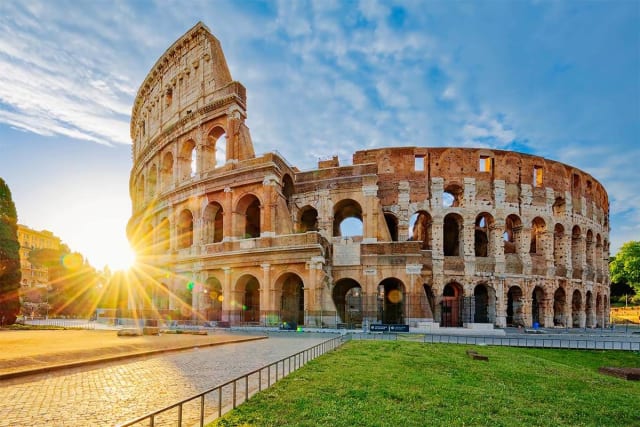
Unlike the Greeks, who were generally happy to exist on their home turf, the Romans sought to expand their empire to the ends of the earth. The philosophical differences in the two societies resulted in massively different enduring contributions to human society. The Greeks were thinkers and tinkerers, giving us very early versions of cranes, gears, screws, wheels and mills. Ancient Greeks also developed the principles for surveying thanks to their mathematical prowess. Viewed through a modern lens, coupled with our understanding of the Greek empire, these inventions are in line with a society that was focused on its small, relatively insular city-states. Each technological invention attributed to the Greeks boils down to a simple question—How can I make mundane tasks easier for myself?
Rome, on the other hand, had much grander ambitions, namely, conquering the world.
This could not be more evident than when thinking about the engineering accomplishments that Rome is still known for today. The Roman ambition to conquer the world and then bring back resources from the far-flung reaches of their empire ultimately led to the construction of a vast network of roads, bridges and aqueducts, many of which can still be viewed today.
Concrete Evidence
Viewed through a modern lens, the Romans were a downright brutal society, sending slaves into the heart of the Coliseum to battle lions and bears to the death. Despite their bloodthirsty personalities and overall lack of contributions to human reason and logic like the Greeks, the Romans were quite technologically advanced, especially when it came to building structures, many of which can still be seen today.
Civil engineers fixate on the roads, bridges and aqueducts the Romans bult, but they also mastered construction of the dome and interior spaces with a clear purpose and specific design. They were able to accomplish these engineering feats thanks to their understanding of concrete. The Romans used concrete as far back as the 1st century A.D.
The Romans had a unique ingredient that made their concrete exceptionally durable—volcanic ash. There was a great deal of volcanic activity around ancient Rome, especially near the Gulf of Naples. The Romans mixed this ash with lime to create a concrete that is stronger, more durable and which has a smaller carbon footprint than modern Portland cement. Modern materials scientists are working to learn from ancient Roman concrete mixes, attempting to incorporate volcanic ash or fly ash from coal plants.
The remarkable Roman concrete opened up entirely new architectural forms, replacing the chiseled marble and granite columns and mud bricks favored by other civilizations. With the ability to form concrete into structurally sound forms, the Romans were well on their way to building the world’s first true infrastructure network. It is as builders that the Romans left an indelible mark on humankind.
All Roads Lead to Rome
When it comes to infrastructure, the Romans primarily focused on moving people, goods and water. Their most important infrastructure developments were roads, bridges, harbors, aqueducts, canals and dams, which were primarily made of their super volcanic concrete. Examples of all are still scattered around Europe across the former reaches of the Roman Empire.
Roman roads, which are similar to the cobblestone streets present in older parts of American cities like Philadelphia, New York and Boston, are also still present across much of Europe. The Romans cemented large stones to form what amounted to an interstate highway system. At the peak of the empire’s building, there were nearly 30 military highways radiating from the capital city and close to 400 smaller roads connecting the Roman provinces.
Those ancient Roman roads today are rutted and bumpy as the concrete holding the stones together has largely worn away. At the time of construction, the stones created a nearly flat surface. Without this network of roads, the Roman Empire’s expansion likely would not have occurred.
For engineers interested in seeing an ancient Roman road, the Appian Way, or Via Appia, is one of the best-preserved examples. This road was once nearly 350 miles long, connecting Rome to the city of Brindisi. It was built in 312 B.C.E. and has a bit of a dark history—as would befit the Romans. In 71 B.C.E., around 6,000 members of Spartacus’s slave army were crucified along this road. Near Rome, the road also became a burial ground for wealthy Romans. Many of their beautiful tombs are still in place along the Appian Way.
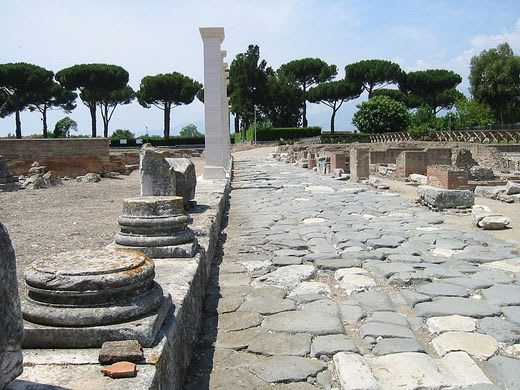
Bridges
Modern highway and bridge engineers enjoy a running debate—Do roads connect bridges or do bridges connect roads? Although we may never have a conclusive answer, the point of the debate is quite clear—the two go hand in hand. You can’t have roads without bridges, and you can’t have bridges without roads. The Romans had roads, so they had bridges.
The Romans were the first humans to build bridges across major bodies of water and certainly the first to build bridges that can still be visited today. Quite objectively, the bridges built by the Romans would be impressive even if they were built 200 years ago. That they were built over 2,100 years ago and many can still be traversed safely is mind-boggling. There are approximately 960 Roman bridges remaining, primarily in Italy and Spain.

Roman bridge construction mastered the arch, which they built out of stone and concrete. Their arches were not always a full semicircle. The Romans often flattened their arches to allow for greater flows during floods. They also installed openings in their bridges’ piers to allow for increased volumes. These innovations and the ability to understand the natural world and its functions—more than any other reason—are why Roman bridges still stand.
Not only did the Romans build stone and concrete bridges, but they also built wooden and pontoon bridges. These bridges have not survived but were innovative in their time. Romans built wooden bridges using cofferdams to allow for the construction of the foundations. These bridges could also be burned or quickly demolished to cut off an attacking army.
Some of the most iconic Roman bridges still standing are the Puente Romano in Merida, Spain, which is the longest remaining Roman bridge at nearly half a mile; the Alcantara Bridge in Alcantara, Spain; the Pons Aemilius, the oldest stone bridge in Rome; and the Pons Fabricus, built in 62 B.C.E., is the oldest bridge still intact and operational from that era. Vehicles are permitted to drive across the Alcantara Bridge, though it has been rehabilitated several times over the centuries due to war.
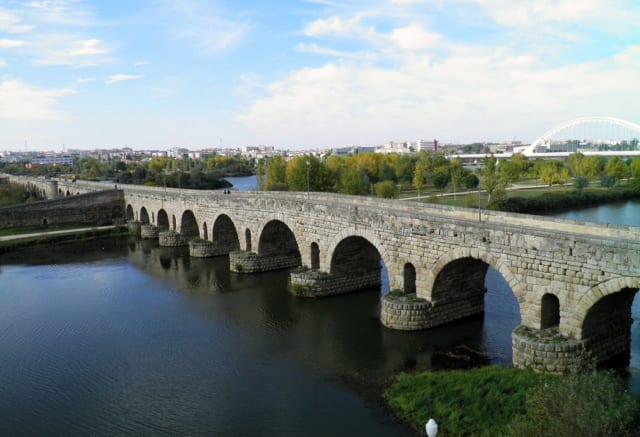
The most impressive bridge built by the Romans was Trajan’s Bridge, located in modern-day Serbia and Romania over the Danube River. Trajan’s Bridge was believed to be over 3,700 feet long and was built in 105 A.D. The bridge consisted of wooden arches, each spanning approximately 125 feet, set on large masonry pillars that were founded on wooden caissons. If you’re thinking this sounds like quite advanced construction, it gets better. The Romans built this bridge in roughly 2 years thanks to their ability to divert the river. At a time of low flow, the Romans dug a canal to the west of the primary channel and then completely drained the river.
Sadly, Trajan’s Bridge did not survive to modern times. It was burned less than 200 years after its construction when the Romans came under attack from the North. Twelve of the pillars that supported the superstructure remain underwater. No arch bridge exceeded Trajan’s Bridge’s total length or individual span length for over a thousand years.
All told, the Romans spanned every large river in their empire except the Nile and Euphrates. The Nile would defy civil engineers until 1902.
Got Water?
The final form of Roman infrastructure that engineers continue to marvel at is the aqueduct. These were very important to ancient Roman society, one that was quite loose with its water usage. Water was a luxury item to the Romans. Whether they were relaxing in their public baths, drinking from water fountains or enjoying indoor plumbing, the people demanded water. The Roman economy also depended on having a consistent water supply for activities like mining, farming and milling.
Unfortunately, the Roman Empire was situated in the heart of the Mediterranean, which remains known for its very dry and very hot summers. Much like modern Americans in the desert Southwest who desire green lawns despite inhospitable conditions, the Ancient Romans weren’t willing to go without water when Mother Nature was unable to supply it.
Enter the aqueduct.
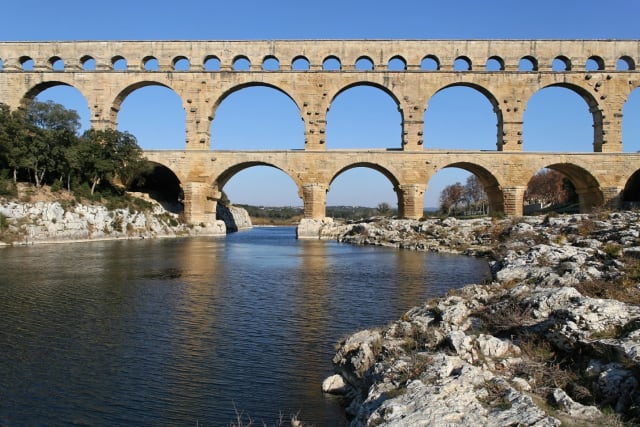
The Roman aqueduct took the irrigation practices of previous civilizations and raised them to another level—quite literally. The Romans could move water thousands of miles through a vast network of pipes, tanks and bridges and channels, some of which were high above the ground. They pumped water, stored it in sedimentation tanks and distributed it throughout their cities. The channels across chasms and valleys are the most obvious remaining component of the system and are quite well preserved due to their location in arid territories of the Roman Empire. Constructed high above valleys and rivers, these bridges have not been destroyed by floods and were not targeted for destruction during modern wars. It is these aqueducts that make modern engineers fully appreciate the Romans’ grasp of engineering and design principles. As with their roads and bridges, it would take well over a thousand years for humanity to come close to replicating the Romans’ water network.
Lessons Learned
Like the question at the beginning of the article—How often should you think about the Roman Empire?
For a civil engineer, the answer should be—quite often!
While working on some of America’s largest bridges in Philadelphia and New Orleans, I marveled at the possibility that any structure could stand for 2,000 years. One hundred years feels like a stretch for a modern steel bridge. Certainly there are differences in the demands modern structures face. No one can expect a Roman bridge to handle 100,000 vehicles a day, for example. But the durability and resiliency of the Roman bridges should be a lesson to us as we try to repair crumbling interstate highway systems that must bend but not break as our climate changes.
We have learned a great deal from the ancient Roman engineers. When we build concrete bridges, cofferdams and caissons are a common construction practice, as is stream diversion. Every new bridge built today has its hydraulic opening analyzed to allow for floodwaters to pass and we use gravity to bring water from our reservoirs and storage tanks built at higher elevations. Roman influence can be seen everywhere in our modern infrastructure.
Humanity has benefitted in immeasurable ways from the engineering breakthroughs of the Romans, but we could stand to benefit by doing our best to channel our inner Roman engineer. Very little of our modern infrastructure will last 2,000 years—something I couldn’t help but think of while watching videos of the New York City subway system bursting apart at the seams during a historic rainfall event.
It is possible to futureproof the things we build in modern times, but could we return to our roots as a creative-thinking species that is willing to work with nature rather than against it, like the Romans did when they turned volcanic ash into one of the strongest, most durable building materials on the planet?
